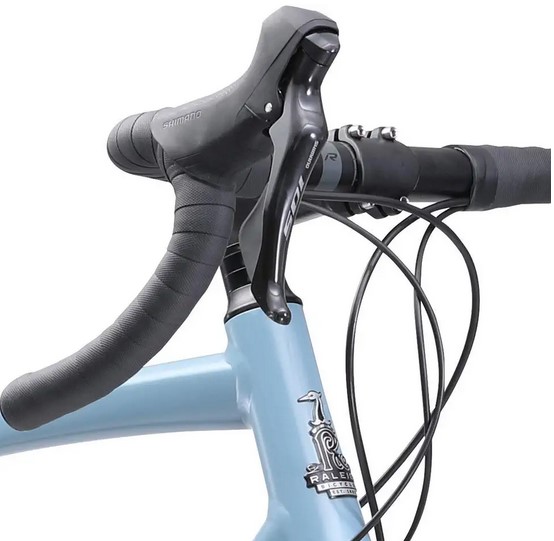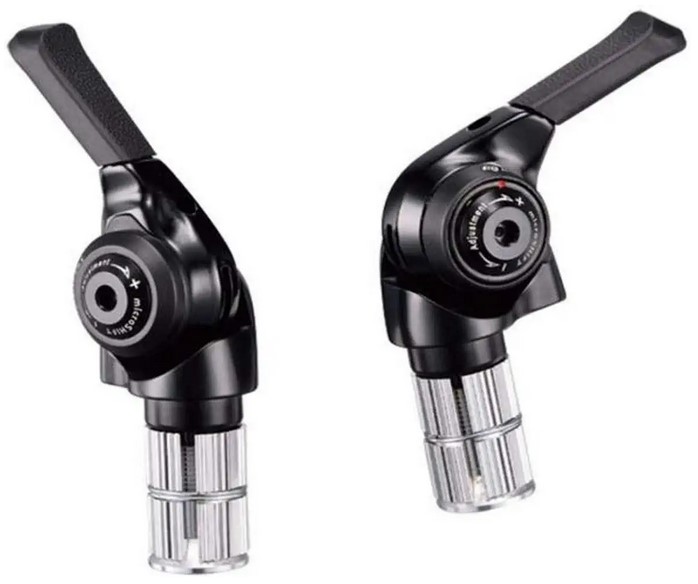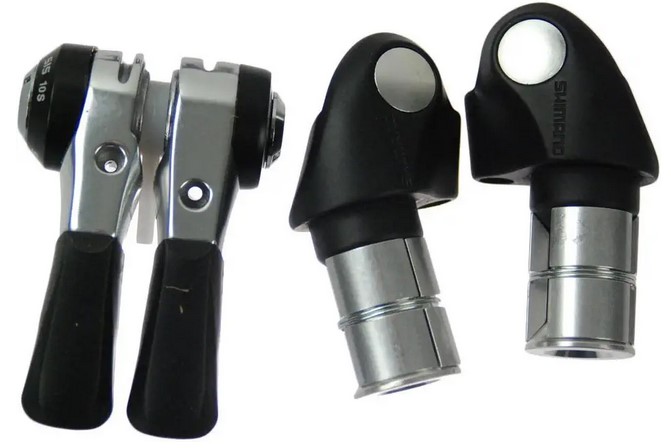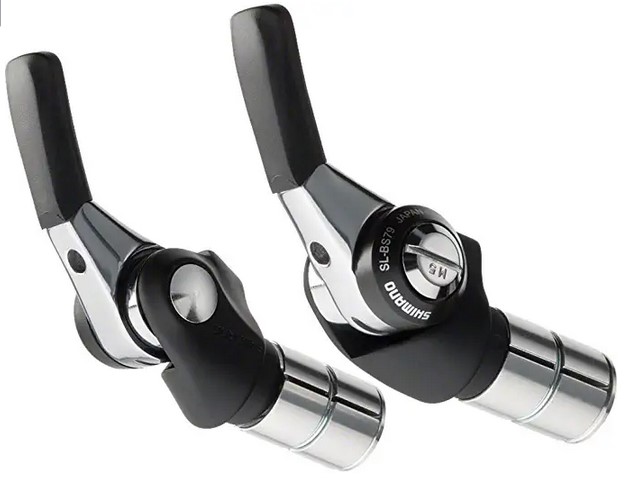Shifters come in various sizes and shapes, and specific shifters are better suited for different riding styles. The touring community still favors friction or bar-end shifters, prompting me to explore why that’s the case, and are bar end shifters good?
Bar end shifters are good for touring through rough patches and muddy terrains because they are reliable. Even if you are not seated, you can easily shift gears despite the trail’s condition with these shifters. They also require minimal maintenance and are pretty effective.
Moreover, these shifters are beginner-friendly because riders don’t have to take their hands off the handlebars to change gears. Therefore, you don’t have to compromise your stability at any given time.

What are Bar End Shifters?
Before exploring the question, are bar end shifters good? Further, it’s essential to know what they are.
Bar-end shifters or bar cons are gear shifts attached to the bike handlebars’ ends, whether drop or straight bars. They are designed to let you change your bicycle’s gears without taking any of your hands off the handlebars.
These shifters provide a practical, versatile, and simple mechanism of gear shifting. They are common in racing and touring bikes, but you can also find them in mountain and hybrid bikes.
Types Of Bar End Shifters
These shifters come in two variations- indexed and friction.
1. Indexed
Indexed shifters are designed with notches in the lever to regulate movement, so you only have to push until it clicks into the next gear. Generally, there are about 8 to 9 indexed positions.
Every shifter’s click loosens or tightens the cable, letting the derailleur move precisely one position down or up. These shifters are precise and easy if properly adjusted.
Consider SHIMANO SL-BS79 Dura Ace Double Bar End (View on Amazon) Shifters with 10 speeds for an exclusively indexed bar end shifter. These excellent shifters are easy to install, shift perfectly, and function smoothly.
Some indexed shifters are fitted with a conversion mechanism that lets you convert them to friction shifters.
2. Friction
Unlike their indexed counterparts, friction shifters don’t have gear notches or a clicking sound. Changing gears with these shifters involves twisting the lever down or up to until you get the gear you want.
The derailleur only moves to the extent that you push the shifter. Additionally, they don’t have a determined distance or pre-set clicks for the bike derailleur to move, making them compatible with any number of gears.
An excellent example of a friction bar end shifter is the Microshift Bar End Shifter Set 8-Speed Road (View on Amazon), that’s also available in an indexed variation. It’s compatible with Shimano MTB and road 8-speed systems.

What are the Pros Of Bar End Shifters?
Here are the reasons that make these shifters excellent for your bicycle.
1. More Current Models
They enjoy a resurgence in their use thanks to adventure cycling forms like touring. Consequently, various companies like MicroShift manufacture newer and improved models.
2. Safer Position
Since these shifters are located on the bike’s handlebars, they facilitate gear shifting while keeping your hands on the handlebars for ultimate control. In addition, it results in less distracting, fast shifting.
However, you must apply some force on the handlebar ends while shifting gears, making staying stable hard.
3. They Can Be Converted To Downtube Shifters
You can tweak a bar end shifter a bit to make them downtube shifters. However, the opposite isn’t true since downtube shifters don’t come with the necessary inserts for the conversion.
Other benefits are:
- They are highly durable
- Easy to install and maintain
- Facilitate easy gear adjustment
- They are lightweight
What Are The Cons Of Bar End Shifters?
1. Expensive
These shifters are relatively costly, with a decent set likely to cost you up to $100.
2. Complex Cable Routing
These shifters’ position and technical characteristics mean the cable housing must run from the handlebars down the downtube. You can take the full install or mid-way exits routing path during installation.
With full install, the cable housing runs across the whole bar to the stem, while in mid-way exits approach, the housing exits midway via the bar tape.
The full install takes up more cable housing and creates more bends, resulting in difficult shifting and greater friction.
3. Reduced Clearance
There’s a high probability of bumping a bar end shifter with your knees and thighs. Moreover, they are susceptible to scratches when transporting the bike.
4. Hinder Installation Of Other Accessories
These shifters prevent you from adding accessories like a bar-end mirror to your bicycle.
Why Are Bar End Shifters So Expensive?
They cost more because they are among the market’s most versatile shifters and can handle more speeds. They also let you switch from indexed to friction to facilitate continued usage when they malfunction.
Moreover, their design also contributes to their high cost. They transfer weight from the handlebars to the bike ends, creating a better distribution.

Why Do Touring Bike Have Bar End Shifters? (8 Reasons)
Bar end shifters provide the serviceability, reliability, and simplicity that touring cyclists looking for a gear with the lowest probability of malfunctioning value.
Riders familiar with the functioning of these shifters gravitate towards them while touring or riding mounts. Their features are well-suited for cycling in rough patches and muddy terrains.
1. They Are Durable
Their high durability is befitting of touring. They seldom get smashed or lead to mechanical issues in a crash translating to a seamless gear shifting and more enjoyable ride.
2. They Are Protected
The Bar end shifters’ low position protects them from front-end crashes. In addition, it’s unlikely that they will be broken, but remember, anything can happen in an accident.
Their small size and placement lower the possibility of dire consequences if you fall sideways. However, the levers’ protruding profile renders them more vulnerable to damage during unexpected bicycle drops.
3. Serviceability
Bar end shifters are manageable to service because they have a straightforward engineering and clean design. You can easily take these shifters apart and service them by yourself, so you can easily restore the broken unit on your touring bike.
4. Simplicity
These shifters have fewer parts, making them more reliable because little things can go wrong. Furthermore, it makes them easier to maintain and repair.
5. Friction Shifting
Bar end shifters typically provide friction shifting at the chainrings (at the front) and the freedom to switch between index and friction shifting at the cassette (at the back). This is a significant reason why touring cyclists choose them.
Friction shifting offers numerous benefits to touring, including
- Compatibility with various drivetrains and triple and double chainrings.
- They eliminate the need for gear indexing, thus letting you correct the inaccuracies without re-indexing the gears.
- Facilitate swift shifting in a continuous swipe from the tiniest to the largest cassette cog.
- Ideal for bicycles with mixed parts.
- Allow front derailleur trimming or adjustment without shifting the gear to prevent the chain from rubbing against the cage of the front derailleur.’
If the rear bar end shifter’s index options malfunction, you can switch to the friction option, preserving the gear efficiency.
6. Give Room For Handlebar Bags
These shifters leave room on the handlebars to hang your bicycle bag or basket without compromising your steering.
7. Independent Brake Systems
The brake system is independent if your bike has a bar end shifter system, increasing the number of viable braking set-ups.
8. Mixing Road And Mountain Bike Parts
Some bar end shifters like MicroSHIFT’s allow you to combine mountain and road bike parts. For instance, you can mix an MTB rear derailleur with drop bars because a bar end shifter can function with 11 or even 12-speed drivetrains.

How Do You Fix Bar End Shifters?
Installing a bar end shifter isn’t complicated as the process is straightforward and identical for the right and left sides. If you follow the instructions precisely, you can get it done in no time.
Here’s what to do:
- starting with one piece, push the shifter’s conical end into the handlebars’ hollow end, ensuring the stop of the cable housing is at the bottom.
- Secure the shifter to the bike’s bar end with a wrench.
- Run the boss of the lever via the hole found on the shifters.
- Put the positioning washer, then verify the projection.
- Fix the grip and tighten the screws through the grip hole lever with your hand. Secure the lever grip to the bar end shifter with a screwdriver.
- Install the cable and cable housing.
- Repeat the process to attach the other piece.
How Do You Ride A Bar End Shifter?
It’s simple to ride a bike with these shifters because of their simplicity and position; even beginners can easily control them.
Changing gears with a bar end shifter involves your palm moving up with the fingers pressing down the lever. It may take time before you perfect how to use them, but you will get there and ride your bike confidently.
You’ll need to grip the shifter firmly at all times. In addition, pull on the shifters up and back as you push down and forward, using your palm to shift the gears.
FAQs
1. Are Bar End Shifters Friction?
Bar end shifters can be friction and indexed, with the rear derailleur typically using indexed shifters, while the front derailleurs using friction shifters. Moreover, you can convert indexed shifters to friction for a more customized shifting or make a malfunctioning set operational.
2. Why Do People Use Bar End Shifters?
Cyclists use bar end shifters in adventure bikes because they are simple, durable, serviceable, protected, and allow friction shifting. You can also use both mountain and road bicycle parts with them and convert an indexed bar end shifter to a friction bar end shifter.
3. Are Bar End Shifters Indexed?
Some bar end shifters are indexed; hence have notches and produce a clicking sound. They offer an easy and precise gear shift if they are well adjusted.
4. Are Bar End Shifters Any Good?
Bar end shifters are great for cyclists in need of a reliable, simple, and durable gear system and don’t necessarily need to shift gears swiftly. They are ideal for adventure bikes, such as touring bicycles.
In A Nutshell, Are Bar End Shifters Good?
With bar end shifters, you get the best of friction and indexed variations packaged in a durable, protected, reliable set that’s straightforward to install and maintain. These shifters help you ride in the gear you want when you want, translating to a seamless riding experience.
Also Read:
